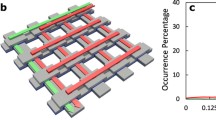Abstract
A memristor is a kind of nonlinear resistor with memory capacity. Its resistance changes with the amount of charge or flux passing through it. As the fourth fundamental circuit element, it has huge potential applications in many fields, and has been expected to drive a revolution in circuit theory. Through numerical simulations and circuitry modeling, the basic theory and properties of memristors are analyzed, and a memristorbased crossbar array is then proposed. The array can realize storage and output for binary, grayscale and color images. A series of computer simulations demonstrates the effectiveness of the proposed scheme. Owing to the advantage of the memristive crossbar array in parallel information processing, the proposed method is expected to be used in high-speed image processing.
Similar content being viewed by others
References
Chua L O. Memristor-The missing circuit element. IEEE Trans Circuit Theory, 1971, 18: 507–519
Chua L O, Kang S K. Memristive devices and systems. Proceed IEEE, 1976, 64: 209–223
Strukov D B, Snider G S, Stewart D R, et al. The missing memristor found. Nature, 2008, 453: 80–83
Williams R S. How we found the missing memristor. IEEE Spectrum, 2008, 45: 29–35
Lewis D L, Lee H H S. Architectural evaluation of 3D stacked RRAM caches. In: 3D System Integration Conference, IEEE, San Francisco, CA, 2009. 1–4
Lu W, Xiong Y, Hassanien A, et al. A scanning probe microscopy based assay for single-walled carbon nanotube metallicity. Nano Lett, 2009, 9: 1668–1672
Jo S H, Kim K H, Lu W. High-density crossbar arrays based on a Si memristive system. Nano Lett, 2009, 9: 870–874
Jo S H, Chang T, Ebong I, et al. Nanoscale memristor device as synapse in neuromorphic systems. Nano Lett, 2010, 10: 1297–1301
Afifi A, Ayatollahi A, Raissi F. Implementation of biologically plausible spiking neural network models on the memristor crossbar based CMOS/nano circuit. In: European Conference on Circuit Theory and Design (ECCTD), Antalya, 2009. 563–566
Tulina N A, Borisenko I Y, Sirotkin V V. Reproducible resistive switching effect for memory applications in heterocontacts based on strongly correlated electron systems. Phys Lett A, 2008, 372: 6681–6686
Raja T, Mourad S. Digital logic implementation in memristor-based crossbars-A tutorial. In: Electronic Design, Test & Applications Symposium, IEEE, Ho Chi Minh City, Vietnam, 2010. 303–309
Yang J J, Pickett M D, Li X M, et al. Memristive switching mechanism for metal/oxide/metal nanodevices. Nature Nanotechnol, 2008, 3: 429–433
Wu J, McCreery R L. Solid-state electrochemistry in molecule/TiO2 molecular hetero junctions as the basis of the TiO2 “Memristor”. J Electrochem Soc, 2009, 156: 29–37
Vontobel P O, Robinett W, Kuekes P J, et al. Writing to and reading from a nano-scale crossbar memory based on memristors. Nanotechnology, 2009, 20: 5204–5225
Blanc J, Staebler D L. Electrocoloration in SrTiO3: Vacancy drift and oxidation-reduction of transition metals. Phys Rev B, 1971, 4: 3548–3557
Kavehei O, Iqbal A, Kim Y S, et al. The fourth element: Characteristics, modelling, and electromagnetic theory of the memristor. Proc R Soc A, 2010, 466: 2175–2202
Biolek Z, Biolek D, Biolková V. SPICE Model of memristor with nonlinear dopant drift. Radioengineering, 2009, 18: 210–214
Zhang Y D, Wu L N, Wang S H, et al. Color image enhancement based on HVS and PCNN. Sci China Inf Sci, 2010, 53: 1963–1976
Author information
Authors and Affiliations
Corresponding author
Rights and permissions
About this article
Cite this article
Hu, X., Duan, S., Wang, L. et al. Memristive crossbar array with applications in image processing. Sci. China Inf. Sci. 55, 461–472 (2012). https://doi.org/10.1007/s11432-011-4410-9
Received:
Accepted:
Published:
Issue Date:
DOI: https://doi.org/10.1007/s11432-011-4410-9




